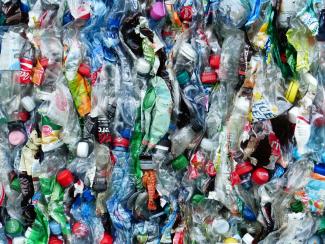According to the Interstate Technology Regulatory Council (ITRC), in 2018, the United States generated approximately 15 million tons of plastic containers and packaging, but only recycled roughly 2 million tons (13%). The majority of that plastic instead was either landfilled (approximately 10 million tons or 70%) or incinerated (approximately 2.5 million tons or 17%). The recycling rate for plastic is much lower than rates for other common packaging materials including glass (31%), paper (80%), aluminum (35%), and steel (75%). As the worldwide rate of plastic production continues to increase exponentially, the impacts of these low recycling statistics are staggering, making potential regulatory or corporate actions to curb plastic production, use, and pollution seem daunting. However, this hasn’t stopped the state of California from tackling the issue head on:
“California won’t tolerate plastic waste that’s filling our waterways and making it harder to breathe. We’re holding polluters responsible and cutting plastics at the source.”
—Gavin Newsom, Governor of California
Plastic Pollution Prevention and Packaging Producer Responsibility Act

On June 30, 2022, Governor Newsom signed the Plastic Pollution Prevention and Packaging Producer Responsibility Act (Senate Bill No. 54 [SB 54]) into law. The law is the first of its kind in the United States to set specific source reduction goals for plastic. It imposes fees and/or regulatory obligations on businesses and entities, including manufacturers of single-use packaging. The final reduction goals are to be met by January 1, 2032. Specifically, the new law will require:
- 25% reduction in plastic packaging;
- 65% of single-use plastic packaging will be recyclable; and
- 100% of packaging will be recyclable or compostable.
The central goals behind SB 54 are to create a circular economy within California and shift the plastic pollution burden from consumers to the plastics industry by collecting $5 billion from industry members over the next 10 years.
The law covers “single-use packaging that is routinely recycled, disposed of, or discarded after its contents have been used or unpackaged, and typically not refilled or otherwise reused by the producer” and “plastic single-use food service ware, including, but not limited to, plastic-coated paper or plastic-coated paperboard, paper or paperboard with plastic intentionally added during the manufacturing process, and multilayer flexible material.” Plastic container producers, retailers, and wholesalers of such covered material must comply with SB 54 unless their most recent annual calendar year gross sales within California were less than $1 million dollars.
There are a few exemptions, however, including for medical products, devices, and drugs; pesticides; infant formula; hazardous materials; and long-term packaging for storage over five years.
California’s Department of Resources Recycling and Recovery (CalRecycle), which oversees the appointment of members to an Advisory Group, hosted informal SB 54 rulemaking workshops and continues to seek input, specifically from the packaging industry, local governments, and retailers.
By January 1, 2024, producers of covered material must join a Producer Responsibility Organization (PRO) and implement extended producer responsibility (EPR) programming. Per an environmental update by Sidley Austin LLP, the PRO will “implement certain methods of source reduction, collection, processing, and recovering of the covered material through registration, reporting, recordkeeping, and auditing requirements.” To do this, the PRO will collect fees from members, from which $500 million will be contributed annually to the California Plastic Pollution Mitigation Fund and $500 million each year to the California Department of Tax and Fee Administration. The PRO will also pay a California Circular Economy Administrative Fee, which will be set by California’s Department of Resources Recycling and Recovery (the Department).
A number of interim goals were put in place to help achieve the law’s 2032 goals:
- 2024 – a list of recyclable/compostable categories will be published by the Department
- 2025 – regulations will be completed and published by the Department
- 2026 – current recycling rates will be released by the Department to help identify areas of improvement
- 2028 – at least 30% of covered material must be recyclable (as determined by producers and demonstrated to the Department)
- 2030 – at least 40% of covered material must be recyclable (as determined by producers and demonstrated to the Department)
Plastic container manufacturers or wholesalers of the “covered material” must comply with the metrics and timelines outlined above, or they will be prohibited from selling, importing, and distributing such materials in California.
Impacts of SB 54
SB 54’s fees and regulatory obligations will impact a variety of entities and businesses including manufacturers of single-use packaging, solid waste collection services, recycling facilities that sort plastics, exporters and transporters of plastics, and retailers who utilize single-use packaging. As explained by legal analysists at Sidley Austin LLP, “The law targets not only manufacturers but sellers of all goods sold in California, and thus will apply to the owner or licensee of the brand or trademark under which the covered product is sold or otherwise brought into California by distributors or retailers.”
The law also imposes requirements for local jurisdictions, recycling service providers, and packaging producers to report statistics on the types and quantities of materials they are transporting, importing, exporting, producing and/or selling to monitor the legislation’s success.
Consistent with its original intent, SB 24 is a far-reaching law with implications for a wide range of organizations throughout California. As rulemaking deadlines and compliance time frames approach, understanding pertinent requirements will be essential to comply with this new law.

